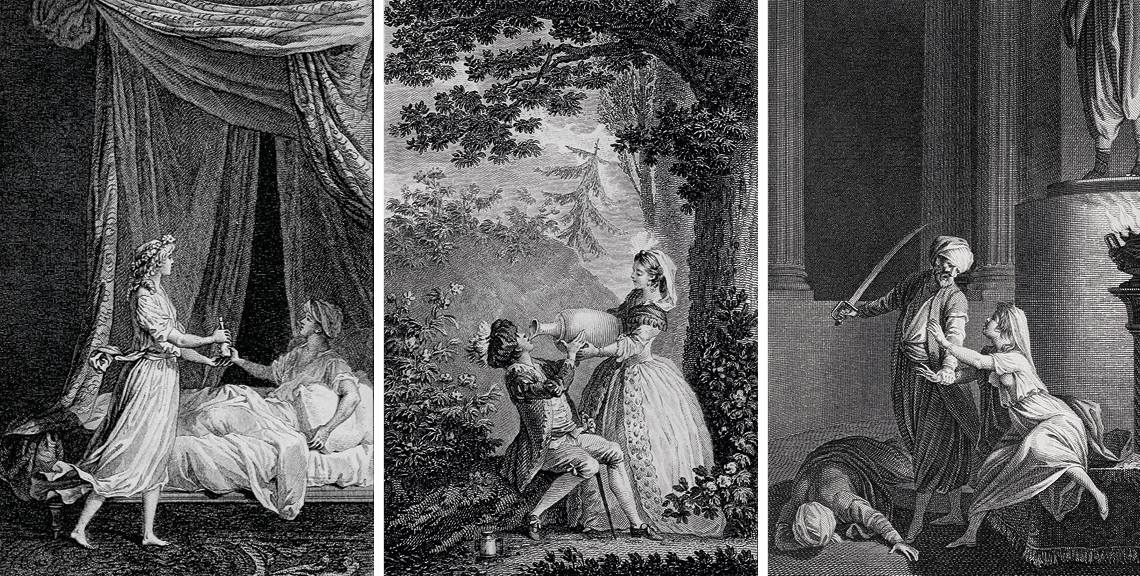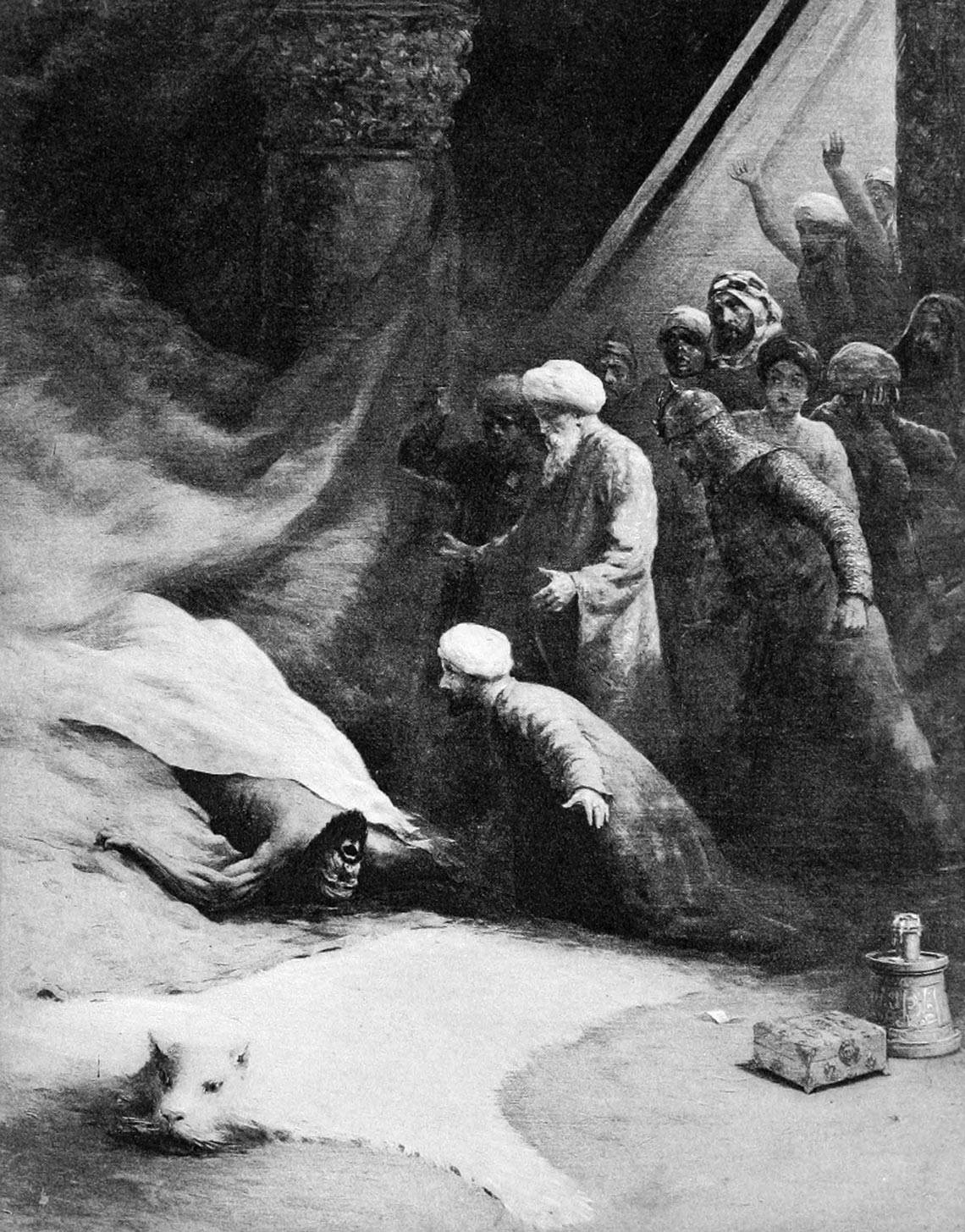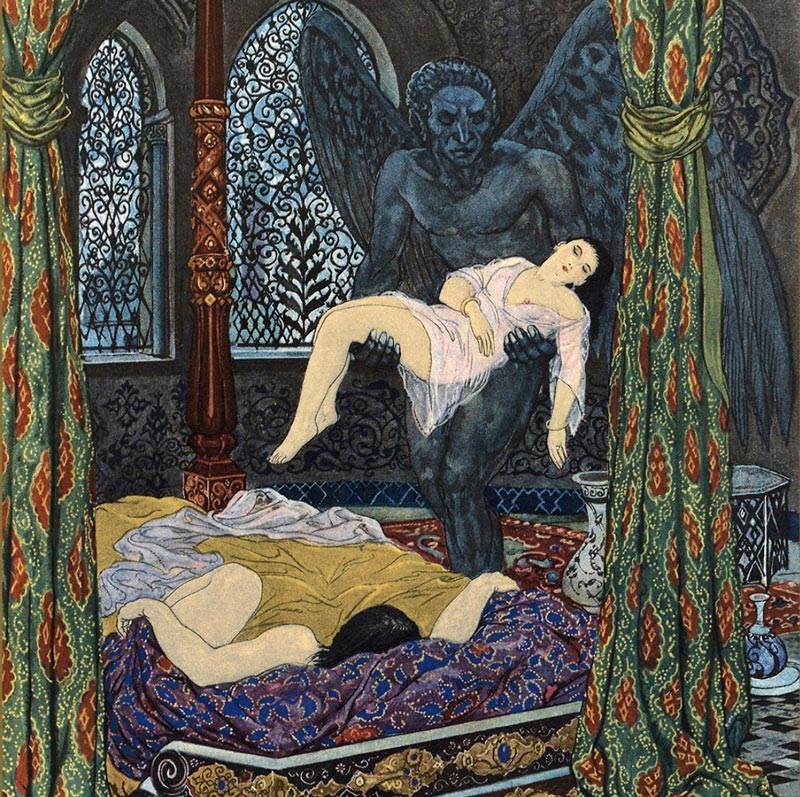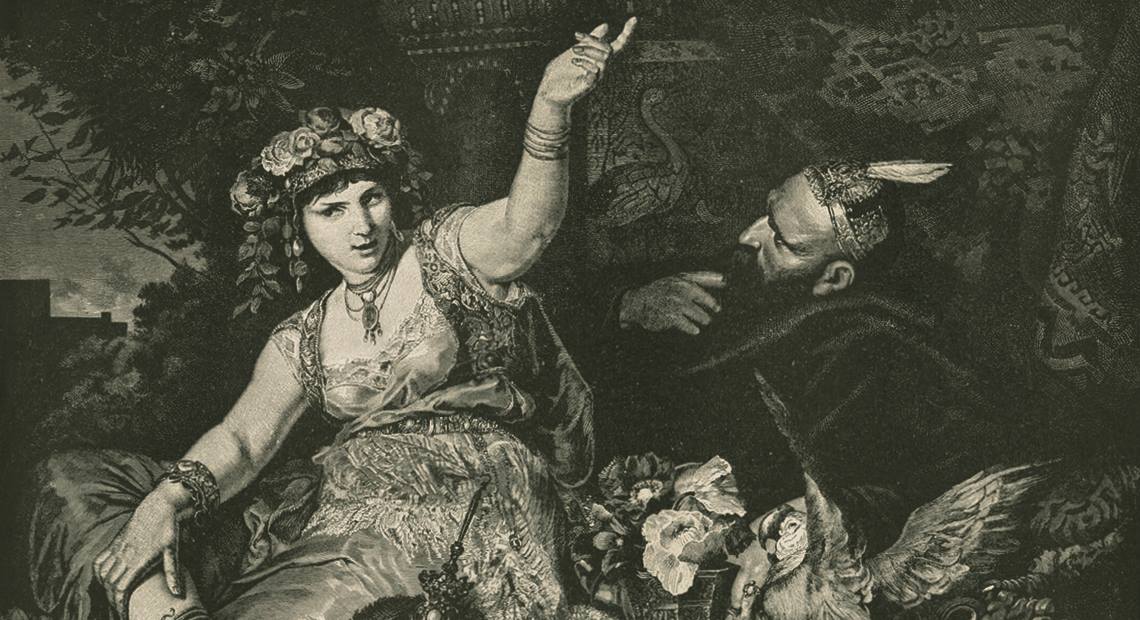The history of the book One Thousand and One Nights, based on manuscripts that date back to the ninth century, is marked by disputes over the authenticity of the stories, criticism of the suppression of certain passages, and debates about how the real world impinges upon the narratives. Stemming from research begun in the 1980s, a recently launched work by Mariza Werneck, a professor of anthropology and literature at the Pontifical Catholic University of São Paulo (PUC-SP), addresses the intricacies of this trajectory, with an emphasis on translations by European authors from the eighteenth century forward.
Similarly, in 2021, as the result of a separate study begun more than 20 years ago, Mamede Mustafa Jarouche, a researcher at the University of São Paulo (USP), completed the fifth volume of his translation of the work directly from Arabic into Portuguese. Jarouche’s version sheds light on the later tales, which appear to have been written to rival earlier versions of One Thousand and One Nights but ended up being incorporated into it. Both works show how, over the centuries, the book’s history has been intertwined with the very narratives it brings together.

Wikimedia CommonsLithograph by Russian artist Ivan Yakovlevich Bilibin (1876–1942) based on the story of Aladdin and the Magic LampWikimedia Commons
A work with no definitive authorship that has its origins in popular Persian and Arab oral traditions, One Thousand and One Nights, also known as the Arabian Nights, uses the story of Sultan Shahriar as a framing device for the other tales. After discovering that his wife has betrayed him with one of his slaves during an orgy, he decides to marry a different young woman each night, who is then murdered at dawn. One day, Scheherazade, daughter of the grand vizier, offers herself for the following night in order to stop the cycle of revenge. By telling stories that captivate the sultan every evening, she postpones her death indefinitely. Historical records indicate the existence, during the rule of the Sasanian dynasty in Persia (third to seventh centuries CE), of a work called Hazar Afsan (A thousand fables), now lost. This work had a prologue similar to the Arabian Nights, but nothing is known about the stories it contained.
“Since the ninth century, manuscripts in Arabic of a work called ‘One Thousand Nights’ or ‘Thousand and One Nights’ have been circulating. Despite the title, the documents did not add up to this number of nights,” says Jarouche, from the School of Philosophy, Languages and Literature, and Human Sciences (FFLCH) at USP. The use of the title “One Thousand,” or “One Thousand and One” is a way of referencing the idea of stories that are infinitely replicated. “Over the years, scribes, compilers, and translators collected, invented, and assembled new narratives to actually arrive at One thousand and one nights,” he says. At the beginning of the eighteenth century, the book was translated into French, then into English and German, and later into Russian, Italian, and Spanish. Eventually, the stories began to be translated into countless other languages.

Wikimedia CommonsIllustrations from the Arabian Nights version by Frenchman Antoine Galland (1646–1715), published in 1785Wikimedia Commons
Interested in understanding the history of the book and its translations, Werneck has analyzed French and English versions of the work. The findings of her study were published in O livro das noites: Memória-escritura-melancolia (The book of nights: Memory-writing-melancholy) (Educ, 2021). “The book’s history is characterized by belligerent relations between its translators,” she writes, in one chapter. Responsible for introducing the stories of the Arabian Nights in the West, the orientalist Antoine Galland (1646–1715) translated the tales from Arabic into French from 1704 to 1717, within the context of the court of King Louis XIV (1638–1715). “Although widely disseminated because of European society’s interest in reading accounts of travels to exotic places, Galland’s work has been considered more of an adaptation than a translation, in that he cut the poems, because he considered them obscure, as well as the long, descriptive passages on characters and the landscape, because he found them excessive, in addition to purging all the erotic content, which he considered obscene,” comments Werneck.
Galland also incorporated narratives told to him by Hanna, a servant from Aleppo, a city located in what is now modern-day Syria. Regarding these tales, Jarouche explains that it would have been Hanna who told Galland the stories of Ali Baba, Aladdin, and Sinbad, some of the most famous of the tales.
Werneck studied a different French translation, by the physician and poet Joseph Charles Mardrus (1868–1949), issued from 1898 to 1904. Characterized by an “obsession with completeness and the literal, and a desire to annihilate the Galland work,” Mardrus’ version “puts to ink everything that concerns the temptations of the flesh,” writes the researcher in her study.

Wikimedia CommonsArtwork by Albert Letchford Burton (1866–1905) of England, for the John Payne translation (1842–1916), published in 1901. The 500 known copies of this book have become relics sought after by collectorsWikimedia Commons
The English translations were the first to draw the attention of Orientalists to a possible Persian origin of some of the book’s stories. Such versions ended up intensifying the polemic character of its history by “transforming the Arabian Nights into a pretext to gather around it a portentous amount of documentation,” observes Werneck. Werneck adds that the notes kept growing in successive translations, reaching seven additional volumes in the case of the work of British orientalist and diplomat Richard Burton (1821–1890), completed in 1888, which emphasizes the erotic stories and obscene scenes.
The Syrian Arabist René Rizqallah Khawam (1917–2004) researched and translated manuscripts of the book for about 40 years, publishing his first edition in 1965. “Unlike his predecessors, Khawam does not separate the stories by individual nights, he organizes the stories into thematic cycles and names them freely, on the grounds that the work was prepared from a manuscript that only he had access to,” says Werneck. “As a common element, all these translators seemed to be more concerned with defending the authenticity of their versions, believing them to be historical documents more than literary texts,” the researcher argues.
In Brazil, the physician and poet Jamil Almansur Haddad (1914–1988) prefaced and edited the translation of One Thousand and One Nights into Portuguese from the French version of Mardrus. The work was performed by a team of translators under his coordination and published by the Saraiva publishing house in 1961. “Mardrus and the Brazilian translators made use of resources from the mnemonic arts from oral history, with detailed accounts of the landscape and the characters. Descriptions of the dresses of princesses, for example, can take up 20 pages, unlike in the version by Galland, who opted for economy of language,” the researcher observes.
Looking at this set of translations, Werneck argues that efforts to emphasize the documentary character of the Arabian Nights, more pronounced in the English versions, ended up denying the fictional nature of the work. “The search for truth in the variants of the stories or in the translations reveals a particular form of disdain for the fictional nature of the book. The insistence on transforming literature into a document, or evidence of truth, is part of an attempt to control the imaginary,” maintains the researcher in one passage.

Tübingen UniversitatManuscripts from the Arabian Nights in the library’s collection of the University of Tübingen, GermanyTübingen Universitat
The stories in One Thousand and One Nights that began to circulate in Brazil were based on three translations from the French version, one of these being the aforementioned work prefaced by Haddad. The first direct translation from Arabic was developed by Jarouche. The beginnings of this work date back to a research grant provided by FAPESP in 2000. That year, Jarouche was at Cairo University, in Egypt, studying the Arabian Nights and another Arab classic, Kalila and Dimna. The following year, at the invitation of Globo publishing house, he began to translate the stories, publishing his first volume in 2005 (see Pesquisa FAPESP nº 115).
In that book and in two following volumes, Jarouche translated tales from fifteenth-century manuscripts, known as the Syrian branch, in chronological order. “For the fourth volume, I decided to do a kind of anthology, selecting stories with different themes, origins, and time frames,” he says. “Dealing directly with the manuscripts offers more opportunities for aesthetic approximations to the original language,” he adds. The Arabic used in the manuscripts, he explains, doesn’t have commas and periods, offering syntactic freedom to the translator, who can choose to write short sentences or connect subordinate clauses. These documents contain vulgar expressions that were not included in previous published editions. An example of this can be found in one of the oldest stories, found in the Syrian branch manuscripts, published in the first volume of Jarouche’s translations. In that story, a young porter from Baghdad enters the house where three girls live and starts drinking and having fun in a kind of swimming pool, where everyone undresses. Although the tale does not contain explicit sex scenes, the characters use numerous words and expressions to designate the female sexual organ. “In the notes, I transcribed and translated all these words, something that isn’t found in other printed editions,” Jarouche says.

Wikimedia CommonsFrench engraving by Léon Carré (1878–1942) created for the story of Princess Budur, translated by Joseph Charles Mardrus (1868–1949) in his edition of the Arabian NightsWikimedia Commons
In the fifth volume of his translation of the Arabian Nights, published last year, Scheherazade narrates the stories of ʿUmar Annuʿmān and his sons, three generations of mythical Muslim kings who lived between Baghdad and Damascus and sought to conquer Constantinople, a city known today as Istanbul, Turkey. The dispute serves as a backdrop for several stories, which involve “hashish addicts, scammers, crazed lovebirds, and lovers mutilated by a blind game of passions,” writes Jarouche in the introduction to the tome.
“To date, around the world, translations of this epic have been made from Arabic editions, in which the original text is censored and reduced by around 40% of its original size,” he explains. Unlike his predecessors, Jarouche chose to translate the work into Portuguese by drawing directly upon manuscripts dating from the fourteenth to nineteenth centuries, belonging to the collections of institutions such as the John Rylands Library, in Manchester, England, the Library of the University of Tübingen, in Germany, the National Library of France, and the Royal Academy of History in Spain. “These manuscripts vary in length and quality, and are full of gaps and illegible sections,” he says. “As a result, before starting the translation itself, I had to ‘fix’ the Arabic text, that is, determine which parts of each document would be used to compose my translation. To accomplish this, I conducted research on 12 different manuscripts.” The researcher further explains that, before being incorporated into the Arabian Nights, the stories of ʿUmar Annuʿmān had been circulated independently. “We may be looking at stories originally created to rival the Arabian Nights, but which ended up being incorporated into it and contributed decisively to completing it,” he thinks.
In the end, pulling from theories formulated by the anthropologist Claude Lévi-Strauss (1908–2009), who considered that in mythology it is not possible to identify originals, Werneck maintains that the Arabian Nights are the sum of all their versions and that it makes no sense to consider some tales to be false. “The stories continue to be invented beyond the book, their interpreters contribute new rewrites and all of them become part of the whole work,” she argues.
Despite having few Arabic translators, the outlook in Brazil is beginning to change, based on the efforts of a group at FFLCH-USP. Functioning as preparatory schools for Arabic scholars intending to work in literary translation, including undergraduate and graduate students, the Contemporary Arabic Poetry Translation Group was created in 2012 by Michel Sleiman. The Tarjama research group was created by Safa Jubran the following year. At Tarjama, the activities begin with micronarratives and short stories by contemporary authors, which are brief and have a simple syntax. “The Arabic short story contains a microcosm of language procedures that translators in training will later encounter in longer texts,” the researchers reported in an article published in 2020. Subsequently, longer narratives were incorporated by authors of diverse origins.
“These research groups are educating a new generation of Arabic translators in Brazil,” explains Jubran, who in 2019 won the Sheikh Hamad Award for International Translation and Understanding, presented by the government of Qatar. She sees a growing interest in Arabic literature on the part of the Brazilian publishing market, a movement driven by countries such as Qatar, and the United Arab Emirates, which in the last ten years have both invested in prizes and literary events. In addition to USP, the Federal University of Rio de Janeiro (UFRJ) also offers bachelor’s and associate degrees in Portuguese-Arabic. In 2019, the Federal University of Sergipe (UFS) created the Center for Arab and Islamic Studies, which works with lines of research on Palestine, geopolitics, history and the Arab presence in Brazil.
Project
The rhetoric in the narrative transformations of the book by Kalila and Dimna and the book One Thousand and One Nights (nº 99/08803-6); Grant Mechanism Research Internship Abroad; Principal Investigator Mamede Mustafa Jarouche (USP); Investment R$71,366.99.
Scientific article
SLEIMAN, M. & JUBRAN, S. Mão na massa! A prática da tradução coletiva. Revista Criação e Crítica. pp. 5–18, Aug. 2020.
Books
O Livro das mil e uma noites: Volume 5. Ramo egípcio: A saga de ʿUmar Annuʿmān e fábulas de Sahrazad. Translation by Mamede Mustafa Jarouche. Rio de Janeiro: Biblioteca Azul, 2021.
WERNECK, M. O livro das noites: Memória – Escritura – Melancolia. São Paulo: Educ, 2021.


